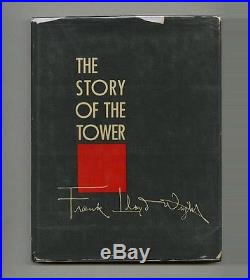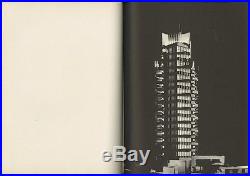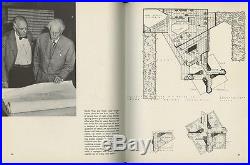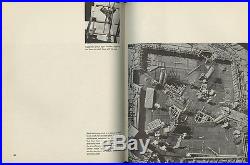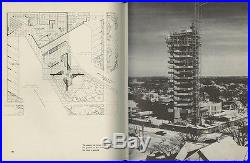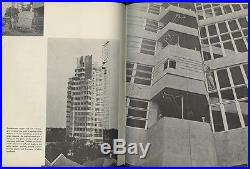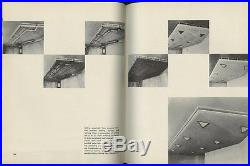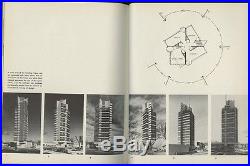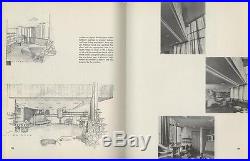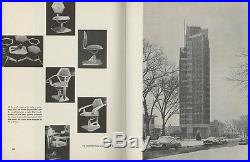THE STORY OF THE TOWER by Frank Lloyd Wright. The Tree That Escaped the Crowded Forest. 1956 First Edition in Dust Jacket. 134 pages, 2 full color fold-outs, 6 color plates and 130 black and white photographs, drawings and plans. Frank Lloyd Wright: THE STORY OF THE TOWER [The Tree That Escaped the Crowded Forest]. New York: Horizon Press, 1956. Black cloth embossed and decorated in copper and Cherokee red. 130 black and white photographs, drawings and plans. Interior unmarked and very clean. Dust jacket edgeworn with chips to front panel and spine ends. A nearly fine copy in a nearly very good dust jacket. 8.75 x 11.25 hardcover book with 134 pages, 2 full color fold-outs, 6 color plates and 130 black and white photographs, drawings and plans. The Story of the Tower includes all of Frank Lloyd Wright’s writings on this subject, revised and brought up to date for this edition. This concept was revolutionary in the history of architecture publishing: for the first time, the evolution of a buildingfrom original idea to plan to day-by-day construction and finally to completionis presented in one full-length book. From The Price Tower website: The Price Tower is a spectacular building of copper and concrete and stands in the downtown area of Bartlesville, Oklahoma. The tower was built for Harold C. Price as a corporate headquarters for his pipeline construction company. Price had originally thought of a rather modest rectangular building a few stories high, however Frank Lloyd Wright convinced him that it would be more economic and efficient to build up rather than out. The unique form of the Price Tower was originally designed by Wright for downtown New York City in 1929, as one of a cluster of apartment towers, but was nonetheless unrealized due to the effects of the Great Depression upon real estate prices and building material costs. Wright was delighted to have the opportunity to build his tower on the plains of Oklahoma, and he nicknamed the building The Tree that Escaped the Crowded Forest because it had escaped the crowded forests of Manhattan skyscrapers and was now able to cast its own shadow upon its own piece of land. At the time of its construction, from 1953 to 1956, the Price Tower was the tallest building in Bartlesville and on the corner of Dewey Avenue and Sixth Street at the southern edge of the downtown area. The nickname also reflected the structural design of the tower. Frank Lloyd Wright was an organic architect and often chose themes and ideas from nature. The trunk of the Price Tower is made of four elevator shafts and their structural walls. The trunk extends deep underground like a tap root and provides the strong support for the upper floors, whose tapering cantilevered concrete floor slabs are like branches. The outer walls do not support the building, allowing for large expanses of window glass. The exterior of the Price Tower is clad in copper panels and sun louvers, the leaves of the tree, whose color was aided by chemical applications rather than due to the effects of nature upon the material. The building also tapers upward like a tree with the top three floors progressively becoming narrower and the penthouse floor only a single suite of rooms. Wright also wished to visually connect the inside of a building with the landscape outside by using similar materials on both the interior and exterior, such as the copper panels, concrete, and aluminum trim. Large windows drew the eye outside toward the view of the Oklahoma prairie, with Wright preferring not to have draperies or artwork on the walls to distract ones eye from experiencing the beauty. Frank Lloyd Wright was interested in the ways in which a society worked and felt that architecture could both transform and improve the landscape while helping create a more functional society. He believed that mankind should build up rather than out so that in a skyscraper one could both work and live, but also have everything you need in the same building. Rather than having these businesses, stores, and offices along one street, he favored a vertical street where they are stacked into a tall buildinghis definition of a skyscraper that would release land for parks, gardens, and the general enjoyment of the towns citizens. Price Tower was designed as four quadrants based on the geometry of a 30-60-90° double parallelogram moduleone quadrant for double-height apartments and three quadrants for private offices. Initially, there were eight apartments in the building, with Bruce Goff living and working in the Price Tower for nearly nine years. The first and second floors of the Price Tower were designed for retail and housed a womens dress shop, a beauty salon, and the offices of the Public Service Company of Oklahoma. On the floors above there were a variety of professional offices with the Price Company occupying the top seven floors of the tower including a sixteenth-floor commissary where free lunches were prepared and served to their employees. The seventeenth and eighteenth floors housed the Price Company corporate apartment and the companys conference room. The nineteenth floor penthouse was the office suite for H. Price and his assistant. The Price Tower commission also allowed Wright to design objects within the building. He designed built-in furniture, free standing furniture, fixtures, textiles and decorative artwork. Many of the designs were produced locally to his specifications. The cast aluminum chairs were manufactured by Blue Stem Foundry, Dewey, Oklahoma, with the built-in and freestanding wood furniture built on site. The draperies and upholstery fabrics were designed by Wright as part of his Taliesin line of wallpapers and fabrics, and were manufactured by the F. Schumacher Company, New York City, in 1955. The towers murals were also designed by Wright, with the corporate apartments mural being the only one he inscribed and signed. The floors and ceilings of the building are made of reinforced concrete. Frank Lloyd Wright liked to build with concreteit could be molded, colored with pigments, and was durable and easy to maintain. The floors of the Price Tower are dyed Cherokee Red, which was believed to be his favorite color, and used on many of his designs. The powdered pigment was added to the concrete while it was still wetand after pouring, the floors were scored with the geometric double parallelogram module. In February 1956, the Price Tower was opened for the public to tour. In 1979, the lobby of the Price Tower was remodeled by Taliesin Associated Architects, Scottsdale, Arizona, as Frank Lloyd Wrights firm was known following his death. The room was completed with the hanging of copper metal draperies to complement the copper on the exterior of the building. The Price Company enjoyed the time they owned and occupied the Price Tower and the Price family continued to operate the company and work in the tower until 1981, when the company relocated to Dallas, Texas. The Phillips Petroleum Company then owned the building for a number of years using it for office space, and off-site storage. In 1987, the Landmarks Preservation Council of Bartlesville began conducting tours of the Price Tower, continuing to do so until 1998. In 1990, the Bartlesville Museum and Sculpture Garden began presenting exhibitions in the tower. Their first exhibition, The Tree That Escaped the Crowded Forest, Frank Lloyd Wright and the Price Tower, was a fitting tribute to the Price Towers role in the community. In 1998, The Bartlesville Museum and Sculpture Garden became the Price Tower Arts Center and Phillips Petroleum began to refurbish the tower, making it compliant with current building codes and removing alterations that had been made to the interior spaces. Once completed, Phillips Petroleum then donated the building to the Price Tower Arts Center, who is the current owner of the Price Tower and its city block. In 2003, Inn at Price Tower, a nineteen-room hotel and Copper Bar + Restaurant opened, providing overnight guests the option to fully experience Wrights design. The Price Tower Arts Center galleries now occupies the two-story space once held by the Public Service Company of Oklahoma and the dress shop and beauty salon. In October 2006, the top three floors of the building were reopened following a three- month restoration to their original 1956, appearance, including replacement of furnishings and replication of original draperies and upholstery fabrics. For an excellent and ever-changing selection of rare and out-of-print design books and periodicals covering all aspects of 20th-century visual culture. Please contact me for details. The item “1956 Frank Lloyd Wright THE PRICE TOWER STORY Bartlesville Horizon Press 1st ed” is in sale since Monday, June 27, 2016. This item is in the category “Books\Antiquarian & Collectible”. The seller is “modernism101″ and is located in Shreveport, Louisiana. This item can be shipped worldwide.
1956 Frank Lloyd Wright THE PRICE TOWER STORY Bartlesville Horizon Press 1st ed
By admin on July 4, 2017
